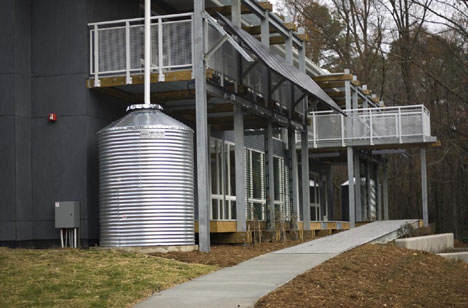Water Wise
Decade of water conservation paying off at Duke

During recent tours of Duke's Home Depot Smart Home, visitors marveled at two 1,000-gallon rain barrels that collect water to flush toilets, wash clothes and irrigate landscaping at the home.
"It's a smart way to save water and help the environment, especially since we're in a drought," said Alessandro Mangiafico, 9, as he toured the home with his parents Paula Mangiafico, a Duke University Libraries archivist, and Paolo Mangiafico, Duke IT-Web Services digital projects consultant.
The Smart Home is one of the latest examples of Duke making wise use of water, a commitment that dates back at least 10 years.
From Duke's state-of-the-art central chilled water system to waterless urinals at the French Family Science Center to the big cistern at Fitzpatrick Center for Interdisciplinary Engineering, Medicine and Applied Sciences (FCIEMAS) that reclaims rain water and condensation for irrigation and other uses, Duke's water conservation projects have saved millions of gallons of water in the past decade.

The cistern at Fitzpatrick CIEMAS.
"People may not realize how much work Duke has done to conserve water during the past decade," said John Noonan, Duke's associate vice president for facilities management. "We started focusing on water management years ago, and the projects we've completed have saved a substantial amount of water. We're constantly exploring other ways to conserve."
Building upon the university's ongoing mission to leave a lighter environmental footprint, Duke announced this month that it will dedicate $5 million for water conservation projects. The new fund will help pay for facilities infrastructure improvements and operational initiatives.
"Water conservation is not new at Duke," said Executive Vice President Tallman Trask III. "Duke has been a leader in environmental stewardship, implementing water-saving projects that go back 10 years. This fund will help us move more quickly to make operational changes at Duke to address the current drought and enhance our ongoing water conservation efforts."
Duke's commitment to water conservation dates back to at least 1996 when the Duke University Board of Trustees allocated $3.5 million for water conservation efforts and energy improvements as part of the Energy Management Program overseen by Duke's Facilities Management Department (FMD).
As part of the eight-year Energy Management Program, major water-saving projects were completed from 1996 to 2004, such as installing low-flow sinks and lavatories in existing buildings, establishing a steam trap maintenance program to repair leaking steam traps and adding a heat recovery cycle that reclaims steam to heat buildings.
These improvements helped Duke earn an Energy Champion Award from the U.S. Department of Energy in 2002, an Award for Excellence from the Association of Physical Plant Administrators (APPA) in 2000 and induction into the Environmental Protection Agency's Star Building Honor Society in 1999.

One of two energy and water efficient Duke chilled water plants.
Duke also has invested more than $50 million to date to build and expand a central chilled water system, which cools campus buildings, laboratories and hospital areas. The system cools buildings by chilling water to 40 degrees and pumping it through underground pipes across campus.
The central system consumes substantially less water than individual cooling systems for buildings on campus, increases energy efficiency and reduces air pollution. More than 40 existing buildings have been hooked up to Duke's two central chilled water plants. Before that, many buildings relied on self-contained cooling systems and dedicated chillers that used more water and energy.
The sloped roof of the newest chiller plant on LaSalle Street reclaims rainwater that is funneled to cooling towers, where it is used in conjunction with city water to meet the cooling tower's water requirements.
Within the next month, the central plant's benefits will be boosted with the addition of the CARL, Sands and Bryan Research buildings.
In addition to saving water by adding more buildings to the central system, FMD recently made a temporary operational adjustment that saves about 9,000 gallons daily at the plant.
"We're now recycling the water that goes through the cooling towers as many times as possible before replacing it," said Darin Smith, manager of chilled water plant operations. "You have to eventually replace the water because it gets dirty, but we've figured out a way to maximize the number of cycles that we can use the water before it needs to be replaced."
Along with facilities improvements in existing buildings to conserve water, Duke has mandated since 2003 that all new construction meet Leadership in Energy and Environment Design (LEED) guidelines, including design elements to conserve water.
"When it comes to water conservation efforts in new buildings, we're taking a full court press approach," said Duke University Architect John Pearce. "In addition to learning from other good examples of sustainable design in the United States, we're looking at other societies for technology that's been part of their culture for years."
For example, he said, waterless urinals, such as those in the new French Family Science Center, are popular in Europe and Asia. The center's 50 waterless urinals and low-flow sinks save nearly 2 million gallons annually. In addition, the center's roof includes 15,000 square feet of sod to filter rainwater and cool the building.
Another example of sustainable design is the Fitzpatrick Center for Interdisciplinary Engineering, Medicine and Applied Sciences (FCIEMAS), which has a 70,000-gallon cistern that reclaims rain water and condensation for irrigation.
"Hundreds of gallons of water is removed from hot humid air brought into the building each day," said Myron Taschuk, an FMD project manager. "We divert reject water from the reverse osmosis water treatment system to the cistern. We also pipe the discharge from the foundation drain sump pump to capture excess groundwater. We're determined to reclaim as much water as we can."